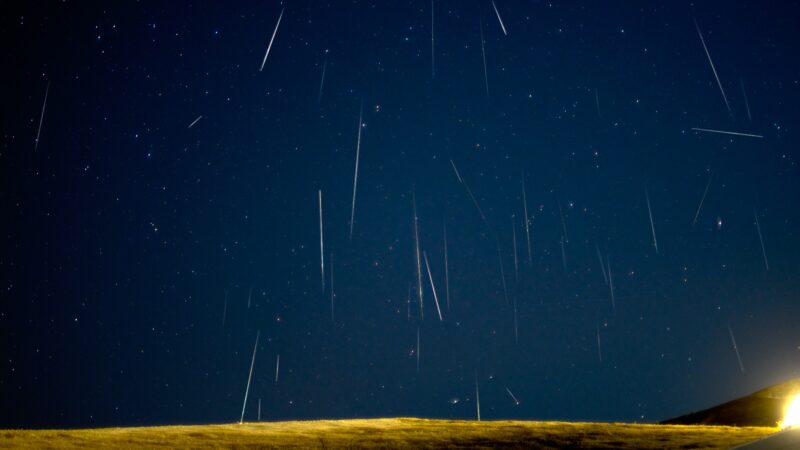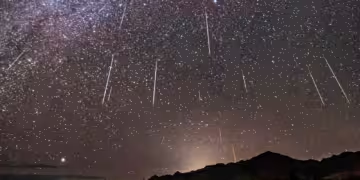Every year, skywatchers eagerly anticipate the Geminid meteor shower, a celestial phenomenon known for its vibrant and prolific displays. This year, the Geminids will peak on the night of December 13–14, 2024, offering stargazers a chance to witness one of nature’s most stunning light shows.
What Are the Geminids?

The Geminid meteor shower is unique among meteor showers. Unlike most, which are caused by debris from comets, the Geminids originate from the asteroid 3200 Phaethon. This asteroid, sometimes referred to as a “rock comet,” behaves unusually, shedding fragments of rock and dust during its close approaches to the Sun. These fragments create a trail that Earth passes through each December, resulting in the Geminid meteor shower.
3200 Phaethon orbits the Sun approximately every 1.4 years, leaving behind a dense trail of debris. When these fragments enter Earth’s atmosphere at speeds of about 78,000 miles per hour, they burn up, creating the brilliant streaks of light we see. The meteors appear to radiate from the constellation Gemini, hence the name Geminids.
Why the Geminids Are Unique
The Geminids stand out for their brightness and intensity. Under optimal conditions, skywatchers can observe up to 120 meteors per hour, making it one of the most prolific meteor showers of the year. Unlike many meteor showers, which produce faint, quick streaks of light, the Geminids are known for their slow, colorful meteors. The colors often range from yellow and green to red and blue, offering a visually stunning display.
This year, however, the viewing experience may be hindered by a 92% illuminated moon, which could wash out the fainter meteors. Even so, the larger and brighter streaks are expected to remain visible, ensuring that the Geminids will still be worth watching.
How to Watch the Geminids
To make the most of the Geminid meteor shower, preparation is key. First, find a location away from city lights, as light pollution can significantly reduce visibility. Once settled, face away from the moon and toward the darkest section of the sky. The meteors will appear to radiate from the constellation Gemini, which will be high in the northern hemisphere sky around 10 p.m. local time.
Dress warmly, bring a comfortable chair or blanket, and allow your eyes about 20–30 minutes to adjust to the darkness. Patience is essential, as meteor watching requires time and focus. Even with the moon’s interference, you can still catch the brightest and most colorful meteors.
Science Behind the Shower
The Geminid meteor shower provides a fascinating glimpse into the behavior of 3200 Phaethon, an asteroid that exhibits comet-like characteristics. Unlike icy comets, which produce meteor showers by shedding water vapor and ice, Phaethon’s debris consists of rocky particles. This makes the Geminids a rare example of a meteor shower caused by an asteroid.
Researchers believe Phaethon’s peculiar behavior is the result of its proximity to the Sun. During its closest approaches, the intense heat causes the asteroid’s surface to crack and release debris. This process, combined with possible past collisions, has created the dense stream of particles responsible for the Geminids.
Viewing Challenges in 2024
This year, the nearly full moon is expected to reduce the visibility of the fainter meteors, a common challenge for skywatchers. However, the Geminids’ bright, colorful meteors make them more resilient to moonlight interference than other meteor showers.
For those unable to watch on the peak night of December 13–14, the Geminid meteor shower remains active until around December 24, providing additional opportunities to witness this celestial event. As long as the skies are clear and free of clouds, you might still catch a glimpse of these dazzling streaks.
How the Geminids Inspire Us
The beauty of the Geminid meteor shower transcends science. For centuries, humans have looked to the skies for inspiration, storytelling, and wonder. Meteor showers like the Geminids spark curiosity and bring people together to share the simple joy of stargazing.
In a world increasingly dominated by technology and urbanization, events like the Geminids remind us of the importance of connecting with nature. They encourage us to pause, look up, and marvel at the universe’s vastness and beauty.
Conclusion
The Geminid meteor shower offers a unique opportunity to witness one of the most prolific and colorful celestial events of the year. Despite the challenges posed by the bright moon, the shower’s larger meteors promise to deliver a spectacular show. Whether you’re a seasoned astronomer or a casual stargazer, the Geminids are an event not to be missed.



















